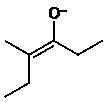This set of Organic Chemistry Multiple Choice Questions & Answers (MCQs) focuses on “Enolates”.
1. Which of the following is the structure of the most stable enol form of 2-methylpentan-3-one?
a) 
b) 
c) 
d) 
View Answer
Explanation: A more substituted double bond is generally more stable.
2. Which of the following is the least abundant aldol adduct formed from an equimolar mixture of ethanal and propanone in aqueous NaOH solution?
a) 
b) 
c) 
d) 
View Answer
Explanation: Adduct (d) is the propanone dimer which is destabilized by the steric strain caused by the geminal methyl groups; the aldol reaction is reversible and a less stable product will be less abundant.
3. An acetoacetic ester synthesis of a ketone proceeds by alkylation of the enolate of the acetoacetic ester followed by ester hydrolysis and decarboxylation of the β-ketoacid. Which of the following methyl ketones is difficult to prepare by this method?
a) 
b) 
c) 
d) 
View Answer
Explanation: The alkylation of the enolate is an SN2 reaction, and sterically hindered alkyl groups are difficult to introduce. However, even dialkylation is possible with reactive alkylating agents.
4. A malonic ester synthesis of a carboxylic acid proceeds by alkylation of the enolate of the malonic ester followed by ester hydrolysis and decarboxylation of the β-dicarboxylic acid. Which of the following carboxylic acids is difficult to prepare by this method?
a) PhCH2CH2CO2H
b) (CH3)2CHO2H
c) PhCH2CO2H
d)
View Answer
Explanation: The alkylation of an enolate is an SN2 reaction, and halobenzene do not react by this mechanism; consequently, phenyl cannot be introduced in this way. However, even dialkylation is sometimes possible with primary alkyl halides.
5. Which of the following is the most stable enolate derived from 4-methylhexan-3-one?
a) 
b) 
c) 
d) 
View Answer
Explanation: A more substituted double bond is generally more stable. The difference in stability between the stereoisomeric enolates.
6. Which enol form of ethyl 3-oxobutanoate is predominant at equilibrium?
a) 
b) 
c) 
d) 
View Answer
Explanation: Conjugation of the C=C double bond with the remaining carbonyl provides a more stable enol, which rules out. Enols may all be obtained by protonation of the same enolate or the readily interconverting stereoisomeric enolates. Of these, It allow stabilizing intramolecular hydrogen bonding; it is the more stable of the two owing to the conjugative stability of the remaining ester group.
7. Which is a wrong structure as a resonance contributor to the most stable enolate form of pentan-2,4-dione?
a) 
b) 
c) 
d) 
View Answer
Explanation: Structure is of a different enolate ion (the position of a hydrogen atom is changed).
8. Which enol form of the following dicarbonyl compound is predominant at equilibrium?

a) 
b) 
c) 
d) 
View Answer
Explanation: For enolate ions of 1,3-dicarbonyl compounds. Conjugation of the C=C double bond with the remaining carbonyl provides a more stable enol, which rules out. Enols may all be obtained by protonation of the same enolate or the readily interconverting stereoisomeric enolates. Of these, allow stabilizing intramolecular hydrogen bonding. NMR evidence indicates that is the more stable of the two presumably owing to the conjugative stability of the remaining amide group.
9. Which enolate derived from 1-phenylbutan-2-one is most stable?
a) 
b) 
c) 
d) 
View Answer
Explanation: Formation of the double bond in conjugation with the phenyl group leads to a more stable enolate, and it is probably more stable (less sterically strained) than the stereoisomeric.
10. Which of the following statements is wrong?
a) The base-catalysed α-halogenation of propanone is first order in the concentration of the base
b) The rate constant for the base-catalysed α-halogenation of propanone decreases in the order Cl2 > Br2 > I2
c) The base-catalysed α-halogenation of propanone proceeds easily to give 1,1,1-trihalopropanone
d) Polyhalogenation of propanone is difficult under acidic conditions, but the products are the same as those obtained under basic conditions
View Answer
Explanation: The rate-determining step of the base-catalyzed α-halogenation is usually the initial proton abstraction to give the enolate, so the rate constant is independent of the identity (or concentration) of the halogen.
Sanfoundry Global Education & Learning Series – Organic Chemistry.
To practice all areas of Organic Chemistry, here is complete set of 1000+ Multiple Choice Questions and Answers.
If you find a mistake in question / option / answer, kindly take a screenshot and email to [email protected]
- Practice Chemical Engineering MCQs
- Check Chemical Engineering Books
- Apply for Chemical Engineering Internship
- Check Organic Chemistry Books
